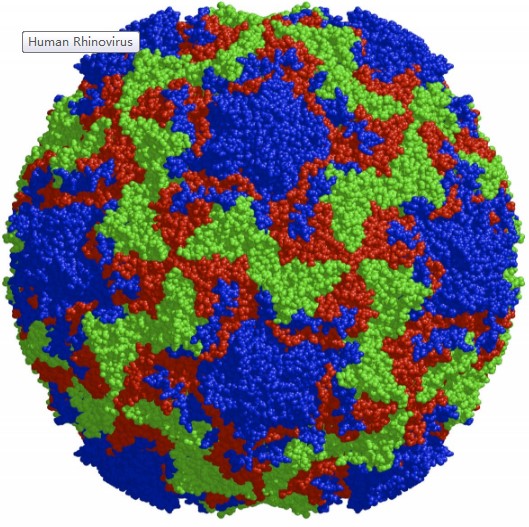Human rhinoviruses (HRV), which include over 100 different virus serotypes, are responsible for a significant portion of common colds experienced each year. HRV have a single positive-stranded RNA genome, which is translated into a polyprotein of over 2000 amino acids. The HRV 3C protease is responsible for the cleavage of viral precursor polyproteins into structural and enzymatic proteins which are essential for viral replication. It is believed that the 2A protease makes the first cleavage at its own N-terminus to separate the structural capsid proteins from the nonstructural ones, while the 3C protease processes most of the remaining sites.
Figure 1. Human Rhinoviruses
Human rhinoviruses
HRVs, members of the family Picornaviridae and the genus Enterovirus, are positive-sense, single-stranded-RNA (ssRNA) viruses of approximately 7,200 bp. The viral genome consists of a single gene whose translated protein is cleaved by virally encoded proteases to produce 11 proteins. Four proteins, VP1, VP2, VP3, and VP4, make up the viral capsid that encases the RNA genome, while the remaining nonstructural proteins are involved in viral genome replication and assembly. HRVs were originally characterized by their growth patterns in human embryonic and monkey kidney cells. However, this system demonstrated limited use, since growth characteristics changed with time in vitro. Three groups of HRVs are now genetically distinguished: group A, group B, and the more recently discovered group C.
A virally encoded enzyme, 3C protease, cleaves viral proteins from precursor polyproteins and is essential for viral replication and the assembly of the virion. HRVs contain a single strand, positive-sense RNA genome which encodes a single viral polyprotein. This polyprotein precursor is further processed by two viral proteases designated 2A and 3C protease.
HRV 2A protease
2A protease (2A) also promotes viral replication in host cells by shutting down both protein synthesis and nuclear-cytoplasmic import and signaling. Of the three rhinovirus species (HRVA, HRVB, HRVC), recent research indicates that species A and C have 2A proteases more efficient at cleaving eIF4G and Nup62 and they are also associated with life-threatening asthma exacerbations in children. It has been proposed that 2A protease may be the virulence factor that determines whether a virus causes a severe asthmatic reaction.
Related Products
| Cat | Product Name |
| DAG1877 | HRV 3C protease [His] |
| DAG3541 | HRV PreScission Protease |
